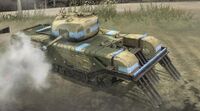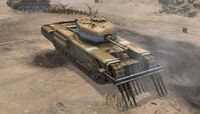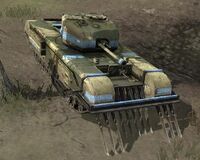Churchill tank MkIV | |||
|---|---|---|---|
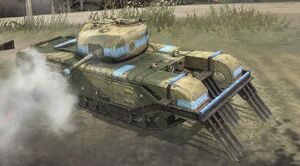 Churchill MkIV in the field | |||
| Army | British | ||
| Role | Heavy Infantry Support | ||
| Unit Cost |
| ||
| Upkeep per Minute |
| ||
| Prereq. | Royal Engineers Support: Churchill Infantry Tank | ||
| Produced By | Company Commander ability | ||
| Primary armament | ROQF 6-pounder Mk III | ||
| Secondary armament | 2x 7.92mm Besa Machine-gun | ||
| Health |
| ||
| Armor | Heavy | ||
| Max. Speed | 3.75 m/s | ||
| |||
| |||
The Churchill Tank, also known as the Churchill Infantry Tank or Churchill Tank Mk. IV, is a British tank introduced in Company of Heroes: Opposing Fronts. Although its main weapon lacks the strength to punch through heavy armor, it makes up for this with superb armor. It is used for protecting an infantry advance against various types of targets, soaking up damage in their stead.
Overview
The Churchill Tank Mk. IV is one of three different types of Churchill tanks available to the British Royal Engineers Support Company. Of these, it is the most straightforward version, and is the first to become available during gameplay.
The Churchill Mk. IV is created by acquiring the Churchill Infantry Tank ability acquired from the Royal Engineers Support Command Tree, which costs ![]() 600 to use and requires
600 to use and requires ![]() 8. You may select a rally point as the destination for the tank when creating it.
8. You may select a rally point as the destination for the tank when creating it.
Like all other Churchill tanks, this tank's primary feature is its heavy armor, comparable to that of the M4 Sherman, but protecting it almost equally from all sides. This makes the Churchill Tank very difficult to destroy, even with dedicated anti-tank weaponry and/or anti-tank infantry flanking.
For this ability, the Churchill Tank pays primarily with offensive capability. Its primary weapon is the ROQF 6-pounder Mk III (57mm) gun, which lacks the armor-penetration capability of most other tank cannons. Nonetheless, this weapon is sufficiently powerful to destroy light vehicles, light/medium tanks, emplacements and buildings, and even infantry concentrations. The Churchill Tank is also somewhat slow compared to other tanks.
Churchill Tanks are used for supporting an infantry advance. They can deal with pretty much any target the infantry come across except heavy tanks, and can soak up a lot of damage to protect the infantry. This allows the Churchill Tank to advance in front of infantry rather than behind it, as it has less to fear from entrenched enemy anti-tank weapons. Churchill Tanks also operate well on their own.
Weapons
The Churchill Tank carries three weapons: A 6-Pounder cannon, and two Besa 7.92mm Machine-Guns.
ROQF 6-pounder Mk III
The Churchill Tank's primary weapon is a 6-Pounder general-purpose cannon. This is a relatively light cannon for a tank, firing medium-velocity shells.
The 6-Pounder causes 87 points of damage per shot. Unfortunately, the Penetration values for the 6-Pounder are weak, meaning that it does only minimal damage to tank armor, and may fail to penetrate the front armor of medium or heavy tanks. Medium tanks can be flanked for side- or rear-damage, but it is unlikely for this gun to actually destroy a heavy tank.
Area Effect values for this cannon are also relatively weak. It can usually kill one infantryman at a time (though its accuracy against infantry is poor), but may kill two if they are close together. It does normal damage to buildings compared to other tank cannons.
The gun has a range of 40 meters, just beyond the tank's line-of-sight.
7.92mm Besa Machine-gun
The Churchill Tank is outfitted with two forward-facing 7.92mm Besa Machine-guns. These weapons provide the tank some ability to kill enemy infantry directly in front of it.
For all intents and purposes, these machine guns are identical to the American M1919a4 LMG, mounted on M4 Sherman tanks. Their primary purpose is to suppress infantry; they are unlikely to kill very often.
The range of these LMGs is 25 meters, around 10 meters less than the tank's line-of-sight.
Upgrades
The Churchill Tank may be upgraded with the Mine Plow.
 Mine Plow
Mine Plow
Once upgraded with the Mine Plow, the Churchill Tank will automatically detonate any mines it rolls over without taking any damage.
Note that units close to the detonation (except the Churchill itself) will take damage regardless, so it's important to have the Churchill Tank drive ahead of the troops to avoid this.
Also note that this ability does not work when the tank is driving backwards.
Unlike the M4 Sherman's Crab Mine Flail' there is no need to deploy or retract the Mine Plow, nor does it affect the vehicle's speed or other properties once installed.
Abilities
The Churchill Tank is capable of applying Tank Shock to suppress enemy infantry. It can also use the Hull Down Position ability once this has been unlocked in the Royal Engineers Support Company tree.
 Tank Shock
Tank Shock
- Costs: Nothing
- Activation: Select Target (Infantry)
- Cooldown: 60 seconds
When Tank Shock is activated, select a target enemy infantry squad. The Churchill Tank will momentarily accelerate towards the target at twice its normal speed. Fearing to be crushed, the target squad, as well as any infantry squad within 10 meters of it, will receive a small amount of suppression, at least as much as required to reach the "Suppressed" state (yellow). Infantry squads inside this area that are already suppressed may become "Pinned".
As of patch 2.06, the ability has been changed. Now, when activated, all enemy infantry in a 10 meter radius suffer Suppression. This ability no longer increases the speed of the Churchill tank, and when the ability is activated it doesnt need to be targeted at any enemy unit.
Also note that this ability keeps consantly suppresing until its over, which means that if an infantry unit wasnt inside the 10 meter radius at the moment they ability is activated, but instead goes in a few moments later, it will still get suppresed. It also means that untill the ability is over the infantry inside the 10 meter radius cant get out of suppresion untill the ability is over or the suppresed infantry gets out of the 10 meter area.
This basically means that the Churchill tank cant be used to charge front against enemy infantry, and instead has to move slowly as the Churchill tank is quite slow.
 Hull Down Position
Hull Down Position
- Costs: Nothing
- Prerequisite: Royal Engineers Support: Hull Down
- Activation: Immediate
- Cooldown: 9 seconds (activate/deactivate)
Once the "Hull Down" ability has been purchased on the Royal Engineers Support Field Improvements chart, it becomes available for all Churchill Tanks until the end of the mission.
To activate this ability, simply click it. The tank becomes immobile as sand bags barricades are erected all around it. The tank can continue firing while this is being accomplished.
Once the process is complete (9 seconds), the tank will have traded its mobility for increased defense. The tank's armor is increased by 25%, and takes only 75% damage from any source.
To release the Churchill Tank from Hull Down Position, simply click the button again. This is only possible once the tank has been fully entrenched - you cannot stop the entrenching process halfway-through. As soon as the button is clicked, the tank is released immediately from the sandbags (which disappear) and may drive off at once.
Tactics
The British faction places a lot of emphasis on mobile defenses and slow advance. This is pretty much the description of the Churchill Tank, whose primary function is to be a slow but tough infantry support tank. The Churchill can almost be thought of as a "mobile emplacement", capable of protecting an approach for a considerable time, but able to move together with your units to provide mobile defense.
On the offense, it advances together with infantry squads, possibly even at the front of the column, and is capable of engaging most targets the formation comes across. On the defense, the Churchill can protect a position on its own for a considerable time, then relocate as the tactical situation requires.
Unlike other tanks, the Churchill Tank has less to fear when advancing at the front of the formation. This is because both its sides and rear are about as well-protected as its front, and it can take a lot of punishment from anti-tank emplacements and anti-tank infantry.
The Churchill Tank can also soak up a lot of damage meant for the infantry it is protecting. While it does so, the infantry can clear out whatever enemies have threatened the tank.
Churchill Tanks can also be used as "mobile emplacements". While capturing a point, position the Churchill Tank to protect the approaches and use the Hull Down Position to increase its armor and damage resistance. This will usually provide ample protection for your Sappers while they work to build permanent emplacements.
On the Offense
When it's time for British infantry to advance, the Churchill Tank can provide a formidable spearhead. Unlike other tanks, which usually advance behind the infantry and wait for options to attack enemy vehicles or flank the battle, the Churchill Tank is often best used at the head of the advance. This is thanks to its heavy armor, which protects its rear and sides almost as well as its front. Running into an anti-tank ambush is far less dangerous for a Churchill Tank than it is for an M4 Sherman or Panzer IV.
Additionally, once a Mine Plow is installed, there is extra incentive to keep the Churchill Tank rolling at the head of the column. Unlike M4 Shermans with Crab Mine Flails, the Churchill Tank does not suffer a speed reduction while clearing mines, and hence does not slow down the advance.
Once the enemy has been engaged, the Churchill Tank has several options at its disposal. If infantry are encountered, it can charge straight into them using Tank Shock to suppress the entire lot, allowing your own infantry to move in for the kill. If enemy light vehicles or emplacements are encountered, the Churchill Tank can usually take them out rapidly with its cannon.
When anti-tank weaponry or medium/heavy tanks are encountered, the Churchill Tank can quickly entrench itself using the Hull Down Position ability. This reduces the amount of damage it receives from all sources, and makes it much more difficult for the enemy weapons to penetrate its hull. This attracts fire towards the Churchill Tank (which most enemies will consider the most immediate threat), buying time for the infantry or other support vehicles to tackle the enemy units.
On the Defense
Defensively, the Churchill Tank is used as a mobile emplacement. Its ability to handle most mobile enemy forces allows it to hold a point almost entirely on its own. This ability is increased further if the tank is placed in a proper position and the Hull Down ability is activated, in which case the tank becomes that much more difficult to destroy.
This is useful during the time between capturing a point and constructing defensive structures to protect it. While the Sappers scramble to erect various defenses, the tank can tackle infantry and light vehicles attempting to counter-attack. It may also be able to hold off enemy tanks for a while, as you construct a 17 Pounder AT Gun to deal with them, or bring in a Sherman Firefly or other Anti-Tank unit.
Once a point is protected, the Churchill Tank can relocate as necessary. Remember however that the Churchill Tank is not the fastest of tanks, and so is not too well-suited for protecting several points at once. It is best when protecting a single point, with the bonus ability of being able to move elsewhere to protect another point.
Weaknesses
Remember that, while heavily armored, the Churchill Tank is not invincible. Powerful anti-tank weaponry can still damage it, and its slow speed makes it more vulnerable to maneuverable opponents and artillery.
Also remember that the tank's main weapon is not very useful as an anti-tank gun. It may fail to penetrate an enemy tank's front armor (or, when dealing with heavy tanks, their side or even rear armor!). When dealing with enemy tanks, keep the Churchill Tank covered by an anti-tank weapon like a Sherman Firefly or even a Cromwell Tank. When advancing into enemy AT fire, make sure to bring infantry along to deal with these threats.
Quotes
Variants
The Churchill Tank is only the basic variant of this tank design. The Royal Engineers Support company has two more types of Churchill Tanks available, which are even more specialized in their anti-infantry capabilities, for which they pay with the basic Churchill's anti-vehicle strength.
- The Churchill AVRE fires a high-explosive shell that can eradicate infantry concentrations and obstacles.
- The Churchill Crocodile uses a flame-thrower to burn out infantry and buildings.
Historical Data
This tank was the product of the British's attempt to follow WWI combat - trench warfare. During the 1940s, the commonwealth knew that the Germans will start another war during their course, and war will be lurking in their corner. It's original designation is the A20. They accelerated the tank's design and production, but only to be halted by the Defeat of France in the same year that it's being produced. With their defeat, trench warfare was no longer credible. So the director of Tank design in Woolwich arsenal, Dr. H.E. Merritt, redesigned the tank, and with its re-designation as the A22, or the MK IV.
This version of the Churchill series sports a ROQF 6-pounder Mk III (57mm) gun, an adequate overall tank gun, but useless against Germany's Panzers. But weighing at around 39 tons with some 152mm armor plating in front, it's one of the most heavily armored tanks that the commonwealth had employed in combat. It can soak a large amount of anti-tank fire, even from heavy Panzers. Later Churchills were rearmed with larger 75mm guns to make them more effective against tougher targets.
The most used variant of the Churchill was the Mark IV.
It does what it was designed for: to breach defenses and let the infantry or other tanks (or both) rush in guns blazing. It has two 7.92mm BESA machine-guns, one in the turret and another one in the hull, making it effective against infantry. It can also be upgraded to have a mine plow in front, so that it can remove mines while it crawls along the battlefield. With or without the upgrade however, it can still crush enemy fortifications like Tank traps and barbed wire.
It's unlocked by using the Royal Engineers Doctrine. Being said that, it is only doctrine-specific and can't be deployed unless the said doctrine is active. With this doctrine active, it can also perform a "Hull-down" move, making it immobile, but increasing its armor significantly.
